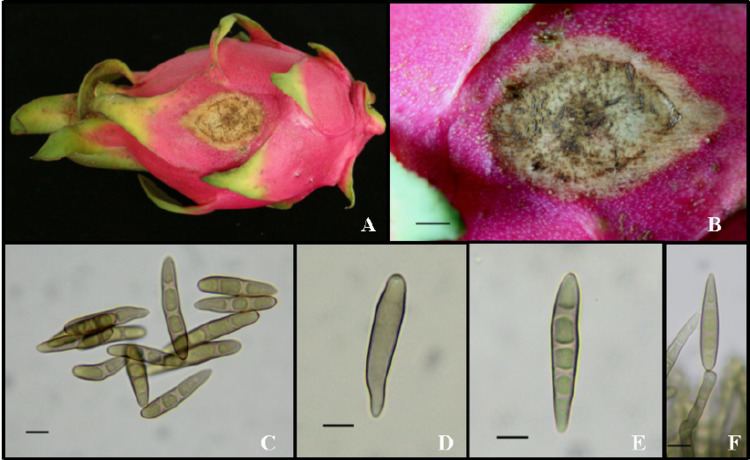Kingdom Fungi | Subclass Pleosporomycetidae Rank Species | |
 | ||
Similar Drechslera, Dothiorella, Neofusicoccum mangiferae, Neoscytalidium, Pleosporaceae | ||
Hosts and Symptoms
Bipolaris cactivora is an ascomycete, causing cactus stem rot and pitahaya (dragon fruit) rot. Also known as Drechslera cactivora, this fungus has been reported causing fruit rot on Hylocereus undatus (white-fleshed pitahaya). This specific cactus is both used decoratively as well as commercially in production of pitahaya fruit. The initial symptoms of the disease, appearing two to three days after inoculation, are yellowish lesions that are water soaked, which progress to a brown color. Seven to ten days after initial appearance of lesions, the rot expands to form large areas of rot which grow dark colored spores. The rot then dries, and the plant dies.
Disease Management
There are currently no fungicides labeled for use to combat B. cactivora in the United States, though difenoconazole has been shown to be effective against the fungus. The recommended cultural practices to combat Bipolaris rot are to limit canopy wetness and to maintain a sanitized field. Irrigating in the morning to allow for the plants to dry throughout the day as well as proper spacing of the plants to allow airflow through the canopy will aid in drying and prevention of conditions suitable for the fungus. Similarly, field sanitation will interfere with the fungus’ ability to overwinter as conidia in plant debris, limiting exposure to the fungus during the following season. Bacillus subtilis and Bacillus amyloliquefaciens have been shown to be effective biocontrol methods for fungus prevention.
Environment
B. cactivora grows fastest in warm, damp, humid environments. It is most severe between 75-91 °F. This is reflected in the countries and regions where B. cactivora is reportedly found, namely Florida, Vietnam, Japan, Korea, Israel, and China. These tropical and subtropical areas are high in both humidity and temperature, making them very conducive to the growth of the pathogen. As cactus for pitahaya fruit is often grown in warm, humid greenhouses in Korea, the pathogen is often found in cactus farms. Spread of the fungus is mediated by wind, irrigation, and rain, so these conditions are helpful but not entirely necessary for fungal growth. Plants that are grown very closely together may similarly have issues with this fungus, as they will make a wet, humid microclimate that is conducive to the growth of B. cactivora.
